Wellesley Scores One for the Environment
By Leah Wallner
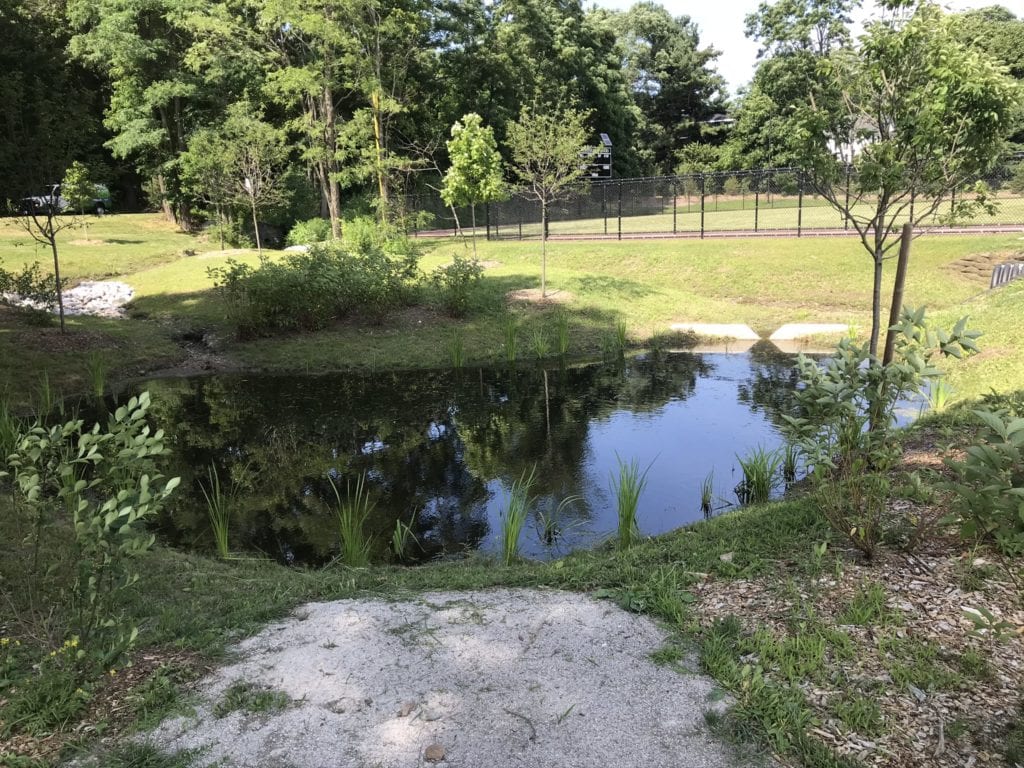
The completed bioretention system at Wellesley’s Hunnewell Fields naturally and effectively captures stormwater runoff.
Balancing Competition
Wellesley residents love their open spaces and their sports, and one place in town they can enjoy both is Hunnewell Field, home to the Wellesley Raiders. The parkland, gifted by town founder Horatio Hollis Hunnewell and under the jurisdiction of the Wellesley Natural Resources Commission (NRC), hosts athletes, spectators, residents, and children on its many playing fields, tennis courts, walking paths, playground area, and picnic tables. Diverse varieties of wildlife and insects call the area home, as well.
The Hunnewell athletic fields are adjacent to the beloved Fuller Brook Park, which recently underwent a five-million-dollar renovation by the town. This project improves stormwater flow, increases water capacity and quality, enhances the parkland, restores historical features in the Olmstead-designed park, and improves wildlife habitat. Recent sightings of bald eagles and large snapping turtles in the area have thrilled residents, and each spring, children with nets help fish traverse a steep section of the brook. The Fuller Brook Park is a two-and-a-half-mile linear park that serves as a means of recreation and alternate transportation through town, and part of it runs right through the Hunnewell Fields.
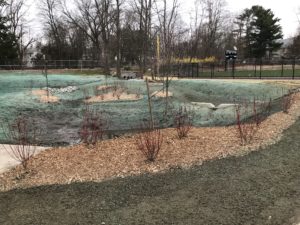
New wetland plants and seed mix await spring.
Stepping Up to the Plate
Several years ago, improvements were proposed to the girls’ softball field, known as the Lee Field, located in the northern corner of Hunnewell Field. Lee Field lacked basic amenities such as dugouts and bleachers; experienced frequent flooding; and was undersized for regulation play, meaning the girls could not host playoff games on their home field. The reason for this: the field was bordered on each of its four sides: on its east by a stand of healthy mature native hemlock trees (an essential natural resource that also provides a buffer to neighboring homes); on its south by the Cochituate Aqueduct; on its north by busy Route 16; and to its west by a meandering stream generated by a stormwater culvert, which bisects the area between the Lee Field and the tennis courts. This stream snaked its way to an overflow drain that diverted the flow underground to another culvert and eventually led to the Fuller Brook.
Despite these physical constraints, the Town was determined to design a solution that would give the girls a regulation-sized field while preserving the natural assets of the parkland.
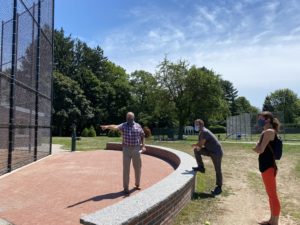
Town Engineer Dave Hickey reviews site work on the softball field.
Pitching an Idea
Weston and Sampson’s landscape architectural firm was called to design a regulation-sized softball field with modern amenities within a sensitive environmental area. A design was crafted that covered the stream, allowing the field to be shifted back from the hemlocks in the outfield. To mitigate the encroachment and loss of “daylighting,” a manmade bioretention system was installed to the left of the left-field foul line. This new wetland area helps collect the commercial, residential, and roadway contaminated runoff from the 34-acre watershed. The drainage stream, now culverted under Lee Field, directs stormwater to Fuller Brook. During rainstorms, the stream can divert its overflow into the new wetland area, which slows down and filters the water, resulting in better water quality entering the Fuller Brook and ultimately the Charles River. Wellesley’s MS4 stormwater permitting is managed by the Town Engineer, and this project will count toward stormwater management improvements.
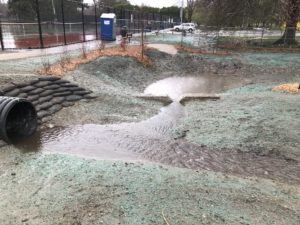
The runoff now has the choice to feed into the new bioretention system or carry onward through a culvert to Fuller Brook.
A Change-Up Results in a Win-Win Solution
The area chosen for the constructed wetland was an existing low-lying area of lawn grass, where soils become seasonally saturated. The Hunnewell Fields are in the lower elevation points in Wellesley. Native trees and vegetation were chosen based on their ability to withstand contaminated soils and filter pollutants. Macro and micro contaminants are now sequestered within the new wetland, and after a time, the “polished” runoff can return on its journey to the brook. Bits of hard mast were sprinkled about as well to help kickstart the mess of an actual wetland. Planners worked to ensure planting “the right tree in the right place,” and native species were used throughout the project to provide food, cover, nesting, and breeding habit for many generations of birds, amphibians, reptiles, mammals, and insects that thrive in the area. Educational signage detailing the creation of the new wetland resource area and the benefits and services it provides complete the project.
Sliding Safely into Home
Any wetlands restoration is an important undertaking, and it’s often helpful to reinvent the wheel. NRC Director Brandon Schmitt believes that we can, and should, always be thinking about how to incorporate natural and functional landscapes into all of our capital projects, even if the original goal is something else, in this case, playing field improvements.
Wellesley residents take great pride in their natural resources and have taken many actions over the years to protect them. The Town recently strengthened its eight-year-old tree bylaw, is participating in the State’s MVP (Municipal Vulnerability Preparedness) Plan and the Charles River Watershed’s Climate Compact, voted a Climate Resolution at Town Meeting, and is embarking on an ambitious Climate Action Plan. Community Preservation Act Funds provided the majority of the funding and were augmented by privately raised donations from the Field of Dreams project. The successfully renovated Lee Softball Field is an example of how active recreation and the natural environment can co-exist for the benefit of all.
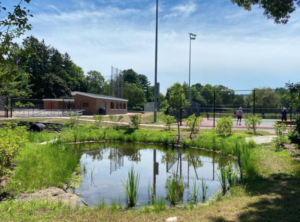
Tennis courts and the newly renovated Lee Field flank a manufactured resource area.
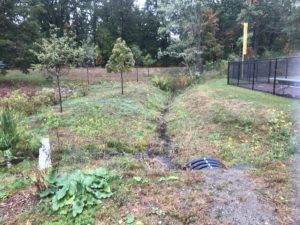
A wild-growing wetland is a happy and healthy wetland. Here native trees, shrubs, and groundcover grow alongside drainage channels.
About the Author
Leah Wallner is the secretary for the Natural Resources Commission in the Town of Wellesley. The environment and natural world have always been a motivating factor for many of her decisions, which made her decision on what to study easy. Attending the University of Massachusetts, Amherst, Leah graduated with her BS degree in Natural Resource Conservation with a Wildlife Conservation concentration in May of 2020. During her time at UMass, Leah spent time working as a teaching assistant for the course “Wildlife Conservation,” participating in multiple research projects and volunteering for the Trustees of Reservations. After graduation, Leah got immediately involved in NRC work. As a western Massachusetts native, she moved east to begin her career in urban conservation, spending a brief time working as a plant healthcare specialist. This job was the stepping-stone to her learning about Wellesley and their Natural Resources Commission. She changed from fieldwork to town work and has since participated in many of the Department’s projects. She is eager and excited to learn and grow to become a strong advocate for conservation and hopes to accomplish big things throughout her career.
***
Each author appearing herein retains original copyright. Right to reproduce or disseminate all material herein, including to Columbia University Library’s CAUSEWAY Project, is otherwise reserved by ELA. Please contact ELA for permission to reprint.
Mention of products is not intended to constitute endorsement. Opinions expressed in this newsletter article do not necessarily represent those of ELA’s directors, staff, or members.

